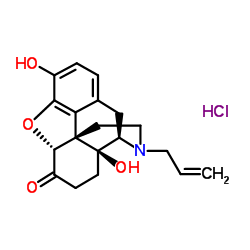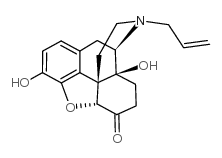357-08-4
| Name | Naloxone Hydrochloride |
|---|---|
| Synonyms |
(5α)-3,14-dihydroxy-17-(prop-2-en-1-yl)-4,5-epoxymorphinan-6-one hydrochloride (1:1)
(1S,5R,13R,17S)-10,17-dihydroxy-4-prop-2-en-1-yl-12-oxa-4-azapentacyclo[9.6.1.0.0.0]octadeca-7(18),8,10-trien-14-one hydrochloride (5α)-17-Allyl-4,5-epoxy-3,14-dihydroxymorphinan-6-one hydrochloride Morphinan-6-one, 17-allyl-4,5-α-epoxy-3,14-dihydroxy-, hydrochloride Narcanti MFCD00069322 17-Allyl-4,5α-epoxy-3,14-dihydroxymorphinan-6-one hydrochloride Naloxone hydrochloride Nalone morphinan-6-one, 4,5-epoxy-3,14-dihydroxy-17-(2-propenyl)-, (5α)-, hydrochloride 17-Allyl-4,5-a-epoxy-3,14-dihydroxymorphinan-6-one Hydrochloride Morphinan-6-one, 4,5-epoxy-3,14-dihydroxy-17-(2-propenyl)-, hydrochloride, (5α)- 17-Allyl-4,5-α-epoxy-3,14-dihydroxymorphinan-6-one hydrochloride NALOXONE HCL (4R,4aS,7aR,12bS)-4a,9-dihydroxy-3-prop-2-enyl-2,4,5,6,7a,13-hexahydro-1H-4,12-methanobenzofuro[3,2-e]isoquinoline-7-one,hydrochloride (-)-N-Allyl-14-hydroxynordihydromorphinone hydrochloride EINECS 206-611-0 (5α)-17-Allyl-3,14-dihydroxy-4,5-epoxymorphinan-6-one hydrochloride (1:1) Narcan (5α)-3,14-dihydroxy-17-prop-2-en-1-yl-4,5-epoxymorphinan-6-one hydrochloride UNII-F850569PQR Morphinan-6-one, 4,5-epoxy-3,14-dihydroxy-17-(2-propen-1-yl)-, (5α)-, hydrochloride (1:1) |
| Description | Naloxone hydrochloride is a potent opioid receptor antagonist. |
|---|---|
| Related Catalog | |
| In Vivo | Naloxone (2.0 mg/kg with constant infusion of 1.7 mg/kg/h) causes a significant improvement in neurobehavioral outcome which persists up to 4 weeks postinjury in rat. Naloxone treatment causes a modest and nonsignificant increase in mean arterial blood pressure (MAP)[1]. Naloxone (0.4 mg/kg) causes memory facilitation and antagonizes the amnestic effect of ACTH and epinephrine in rat[2]. Naloxone treatment diminishes the strength of the initial tetanus in a dose-related manner in cats. Naloxone (5 or 10 mg/kg, i.v.) causes subsequent doses of morphine to produce less PTP depression but has no effect on maximal twitch depression[3]. |
| Animal Admin | Young adult Wistar rats are used in the assay: females for experiments l and 3 (age 50-70 days, weight 100-185 g) and males for experiments 2 and 4 (age 51-69 days, weight 140-200 g). The same apparatus is used for both: a 50×25×25 cm box made of plywood with a frontal glass wall, whose floor consists of 1 mm-caliber bronze bars spaced l0 mm apart. In task l, a 5 cm high, 25×25 cm wooden platform is introduced into the box so as to cover the left half of the grid. Rats are held gently by their bodies and loared onto the platform facing the rear left corner, at which time a quartz chronometer is activated. Time is counted until the animals stepped down from the platform and placed their four paws on the grid, upon which a 0.5 mA, 60 Hz footshock is continuously delivered until the animals return to the platform. In task 2 the platform is only 7 cm wide and covered only the leftmost seven bars of the grid; the footshock is of only 0.3 mA and is delivered in 0.4 msec pulses once every 2 sec until the animals climb back onto the platform. Immediately after training in each task the animals are withdrawn from the box injected i.p. with one of the following: saline (1.0 mL/kg), ACTH1-24 (0.2 or 2.0 μg/kg), epinephrine HCl (5.0 or 50.0 μg/kg), human β-endorphin (0.1 or 1.0 μg/kg), naloxone HCl (0.4 mg/kg), or ACTH or epinephrine given together with either β-endorphin or naloxone. All drugs are dissolved in saline to an injection volume of 1.0 mL/kg. Twenty-four hr after training the animals again are placed on the platform (the wide one for task 1, experiments 1 and 2, and the narrow one for task 2, experiments 3 and 4), and their latency to stepdown onto the grid again is measured as in the training session. A ceiling of 180 sec is imposed on this measure. |
| References |
| Boiling Point | 532.8ºC at 760 mmHg |
|---|---|
| Melting Point | 200-2050C |
| Molecular Formula | C19H22ClNO4 |
| Molecular Weight | 363.84 |
| Flash Point | 276.1ºC |
| Exact Mass | 363.123749 |
| PSA | 70.00000 |
| LogP | 2.04130 |
| Storage condition | 2-8°C |
| Water Solubility | ethanol: 3.3 mg/mL stable for several months refrigerated if protected from light. |
CHEMICAL IDENTIFICATION
HEALTH HAZARD DATAACUTE TOXICITY DATA
|
| Hazard Codes | Xi: Irritant; |
|---|---|
| Risk Phrases | R36/37/38 |
| Safety Phrases | S22-S24/25-S26-S36/37/39 |
| WGK Germany | 3 |
|
~% 
357-08-4 |
| Literature: US2003/69263 A1, ; |



